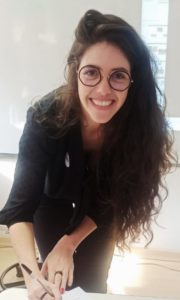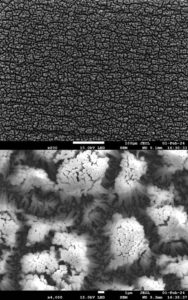Vanessa targeting terbium production 155
Vanessa Rhoden is Brazilian, but she chose to settle in France to do research. A few months into her PhD at the Subatech laboratory, she shares her enthusiasm and the initial results of her work on the fabrication and characterisation of targets for the production of terbium 155, a promising gamma emitter for SPECT imaging.
 After completing her master’s degree in chemical engineering at the University of Rio (UFRJ), the young woman looked for a thesis in France. “I really wanted to go into health research, leave Brazil where it’s very difficult to get researcher position, and join my boyfriend who’s been in France for several years”. She was immediately enthusiastic when she found out about the project suggested by Thomas Sounalet and started discussing it with the scientist who is now her supervisor. “” We aim to start producing terbium 155 (Tb-155) from gadolinium (Gd) targets obtained by different electrodeposition techniques: molecular plating, molten salt electrodeposition and pelletising. All with the best possible yield. To achieve this, we need targets that stick well to their substrate, are uniform and have very few cracks,” explains the PhD student.
After completing her master’s degree in chemical engineering at the University of Rio (UFRJ), the young woman looked for a thesis in France. “I really wanted to go into health research, leave Brazil where it’s very difficult to get researcher position, and join my boyfriend who’s been in France for several years”. She was immediately enthusiastic when she found out about the project suggested by Thomas Sounalet and started discussing it with the scientist who is now her supervisor. “” We aim to start producing terbium 155 (Tb-155) from gadolinium (Gd) targets obtained by different electrodeposition techniques: molecular plating, molten salt electrodeposition and pelletising. All with the best possible yield. To achieve this, we need targets that stick well to their substrate, are uniform and have very few cracks,” explains the PhD student.

Vanessa initially focused on molecular plating, trying to determine the optimum concentration of gadolinium and the best solvent through a series of experimental tests carried out at GIP ARRONAX. She comments on her initial results with images: “Here we can see the joining of many and many atoms. When a voltage is applied to obtain a material, it tends to behave like a kind of filament, which is why we see this shape on ths sample. I pay close attention to the shape of the deposit, the interstitial distance of the sample, whether it is uniform or not, and the shape and distribution of the cracks. Thanks to the SEM images, I can take measurements such as the height of the deposited Gd. I also assess whether the adhesion to the substrate is good or not and whether there is some sort of preferred trajectory or deposition point in the sample.”
The scientist, still speaking a little hesitantly in French, is delighted with her choice and realises how lucky she is: “Living and working here in France is less tiring than in Brazil. I feel good here. I also really appreciate having all the equipment on site at Arronax to analyse my samples. In Brazil, I had to keep running from one laboratory to another.
Vanessa Rhoden’s PhD thesis is funded by the CNRS. She is co-supervised by Nathalie Michel (Subatech) and Ferid Haddad (GIP ARRONAX)
Contact : Vanessa Rhoden

